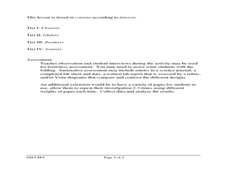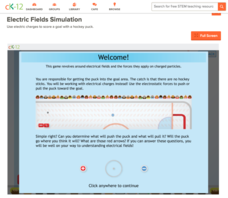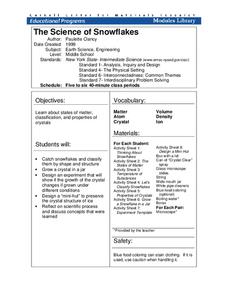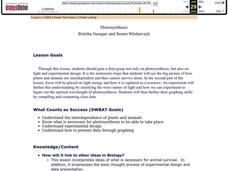Curated OER
Physical Principles in Living Systems
Seventh graders experiment with white light, plane mirrors, and curved mirrors in order to demonstrate the physical principles of living systems. In this physical principles lesson plan, 7th graders take 3 days to discover what happens...
Curated OER
Physical Changes and States of Matter- Two
Third graders explore the concept of evaporation as they observe how the water level changes in a cup that is left out. Working in groups they observe physical changes in a group of everyday items. They record the changes in shape, size,...
Curated OER
Character Attributes in Writing
Third graders analyze the importance of characters in fiction writing and performances. In this theatre instructional activity, 3rd graders identify the important characteristics of a fictional character and how to portray a character...
Curated OER
The Physics of Cell Phones
Students explain how cell phones work. In this physics activity, students describe the advantages and advantages of having one. They identify the different parts of a cell phone.
Curated OER
The Physics of Flight
Students discuss how the invention of flight changed the way people live today. In groups, they compare and contrast the differences between weight, lift, thrust and drag. Using these principles, they create a glider and propeller with...
Curated OER
Physics of Sound: How We Hear Sounds
Students examine the way they hear sounds. In groups, they label and identify the functions of the different parts of the ear. After reading a book by Helen Keller, they research the mechanisms of sound and how sounds are different...
Curated OER
Physics of Sound: How We Hear Sounds
Second graders identify the different function and parts of the ear. In this physics lesson, 2nd graders explain how we hear sound. They read about the life of Helen Keller and respond to questions that follow.
Curated OER
Physics "24"
Students construct a model house or school. In this physics lesson plan, students research about who wind up clocks work and write an essay about it. They determine the center of gravity of different objects.
Curated OER
Origami Flight: The Physical Setting
Sixth graders investigate the forces that move certain objects. In this physics lesson, 6th graders design and create paper flying objects using origami methods, which they practice flying in different conditions. Students record and...
CK-12 Foundation
Electric Fields Simulation
Can you get the puck into the goal using only electric charges on the ice? Scholars experiment with electrostatic forces as they determine which charges pull the puck and which repel it. Multiple levels reinforce different related...
Geography for Geographers
Five Themes of Iceland
How do the five themes of geography relate to the country of Iceland? Pupils learn about everything from the differences between relative and absolute location to how humans both adapt and change the environment. The presentation...
Curated OER
Designing a Hiking Trail
Put your students' map skills to the test with this engaging cross-curricular project. Given the task of developing new hiking trails for their local community, young cartographers must map out beginner and intermediate paths that meet a...
Cornell University
The Science of Snowflakes
Who can grow the best crystals? Challenge class members to develop strategies for enhancing growth in the crystals. Through a lab investigation, learners study the properties of crystals and test the effectiveness of different growth...
Intel
Help Wanted! Physicist
Groups discover physics as they take an assigned scenario, perform research about different aspects of the subject matter, and present their findings to the class. From the presentations, learners must develop and support a point of view...
NOAA
Into the Deep
Take young scientists into the depths of the world's ocean with the second lesson of this three-part earth science series. After first drawing pictures representing how they imagine the bottom of the ocean to appear, students investigate...
Curated OER
Mountain Magic: Identifying the Basic Physical Characteristics of Mountains
Students read about and identify on maps the physical characteristics of mountains. In this mountains lesson plan, students also write about the characteristics using personification.
Curated OER
Physical and Chemical Changes
Students examine the different changes in matter. In this chemical change lesson students determine the amount of reactant made in a reaction using the law of conservation.
Curated OER
Describing the Physical World
In this physical world worksheet, students review concepts relating to the chemical and physical properties of matter, density of matter, and if matter is a solid, liquid, or gas. This worksheet has 9 terms in a word puzzle, 4 true or...
Curated OER
Puberty
Learners investigate the concept of puberty. They examine the social and emotional changes that take place. Individual students examine the kinds of changes they will go through. They are taught some coping strategies to deal with the...
Special Olympics
Train at School
Here is a fantastic compilation of adaptive physical education lesson plans that cover the major concepts of physical fitness, including: aerobic endurance, balance, coordination, flexibility, power, speed and agility, and strength.
Curated OER
Playing With Science
Young scientists investigate the scientific concepts and principles that help make common toys such as hula hoops, yo-yos, slinkies, and silly putty work. As a class, they read "Backyard Rocket Science, Served Wet" to get a look behind...
Curated OER
Photosynthesis
Students recognize the importance of plants as they perform an experiment involving photosynthesis. Students determine the optimum wavelength of light for photosynthesis by exposing plants to different colors of light, collecting data,...
It's About Time
The Mu of the Shoe
What is mu? Emerging scientists explore the coefficient of sliding friction, or mu, and apply its concepts as they complete activities in the interesting lesson. They measure the sliding friction between soles of their own athletic shoes...
Colorado State University
What Is a "Model"?
Model the transfer of energy during a typical 24-hour period. Young scholars use a game-like approach to learning the patterns of heat transfer through the day and night. Groups of four exchange different tokens as the energy transfers...

























